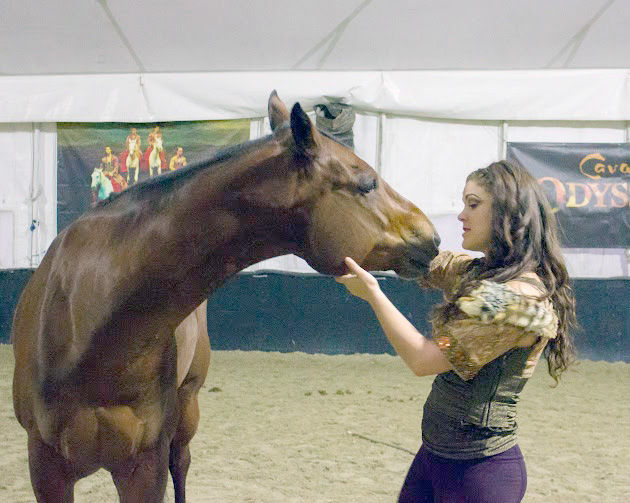
The white horses entered with a pattering of feet, heads held high, necks arched, running to greet the trainer at the center of the ring, then spinning in tight circles that caused a gasping audience. The nine four-legged stars performed freely without halters or bridles and were part of Cavalia’s new show, Odysseo, which opened in San Francisco on Nov. 19.
The horses were so clean it was difficult to imagine that about a week before, they had been playing in the dirt during a vacation at Gilroy Gaits off Frazier Lake Road in the Hollister area.
“Our horses are herd animals so when we turn them out together, we get to see them just be playful,” said Rider Spencer Rose, 24, of Exeter.
Rose was familiar with Hollister, even before she went to visit the horses she trains during their 10-day holiday. About 10 years ago, she participated in the San Benito County Saddle Horse Show & Rodeo and stayed at the Cinderella Motel off San Felipe Road.
That was before Rose was hired to work as a trick rider for Cavalia. Recently, she became part of the company’s second show, Odysseo. That show—extended in San Francisco through Jan. 10 due to popular demand—is a marriage of Cirque du Soleil-style antics and an elaborate performance focusing on the beauty, power and grace of horses.
The show features women in silk dresses Roman Riding with a foot on each of two horses. Men wearing pogo-stick leg extensions do nearly impossible jumps and an aerial artist hangs first from his ankles and then from his neck. Another rider slides all the way under a running horse and ends up safely on the other side.
The show is a world tour of sorts, though some of the places might exist only within the confines of the 47,000-square-foot performance tent. In one scene, horses appear in front of stone statues that look to be part of Chile’s Easter Island. Later, performers strutted in front of orange rock formations that resembled the Grand Canyon. Then, there was a dance scene with African flare, in which singers begged the audience to join them in chanting for an end to war.
The journey comes to life with the help of more than 60 horses and about 45 artists. The breeds of horse on display include Arabians, Lipizzaners, Lusitanos, Mustangs, Quarter Horses and Spanish Purebreds.
Rains poured on to the stage just after intermission, flooding it with water. A horse danced high steps above the growing aqua blue lake, then pranced down to the water’s edge and entered it.
The production used live music—with musicians visible high in the trees to the left and right of the stage—so that scenes could be adjusted to fit horses’ performances.
“Our horses are our rock stars by far,” Rose said.
The group travels with two veterinary technicians, plus a farrier—a craftsman who tends to any horsey feet or shoe needs—on staff. They have a veterinarian on call each place the company visits. Every few months, a horse masseuse works with the equine athletes, relieving any built up stress.
Each trainer works with three to four horses. There are seven shows each week, but the animals perform in just six.
Rose, this show’s head Roman Rider, has a soft spot for 8-year-old Calibre, a Bay quarter horse she taught to bow, lie down and carry a human. The horse was purchased for the other show but due to a miscommunication, he had only ever had a saddle on him three times, Rose said.
Now the horse can participate in three scenes: the liberty ones where horses follow trainers unfettered by lead lines; Roman riding; and trick riding.
The equines appear on stage just 10 to 15 minutes in each show, and trainers invent other things to keep them active when they’re not performing, Rose explained.
Rose’s favorite number is the one where 32 horses and eight riders enter the circular stage. Riders—Rose included—must control a team of four horses and keep them in a line with just the help of a whip that extends the reach of their arm.
“All you have at the end of the day is your voice and the trust that you’ve built with them,” she said.
So far, Rose has performed in six countries—including Canada, Singapore and the United Arab Emirates—but arriving in San Francisco this month was a coming home of sorts. The city was the first one where she performed for the Cavalia show five years ago. She’s been with the company’s newer performance, Odysseo, for about eight months.
As for why stallions and geldings are in the show but not mares—female horses—Rose compares the situation to humans.
“Boys don’t get a lot of work done with females around,” she said.









